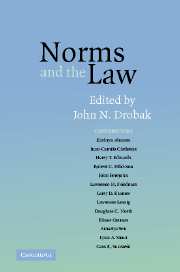Book contents
- Frontmatter
- Contents
- List of Contributors
- Acknowledgments
- Introduction
- PART ONE RATIONALITY AND NORMS
- PART TWO NORMS OF THE COMMONS
- 4 Norms of the Household
- 5 .commons
- 6 How Norms Help Reduce the Tragedy of the Commons: A Multi-Layer Framework for Analyzing Field Experiments
- PART THREE JUDICIAL NORMS
- PART FOUR THE INFLUENCE OF LAW ON NORMS
- References
- Index
4 - Norms of the Household
Published online by Cambridge University Press: 05 June 2012
- Frontmatter
- Contents
- List of Contributors
- Acknowledgments
- Introduction
- PART ONE RATIONALITY AND NORMS
- PART TWO NORMS OF THE COMMONS
- 4 Norms of the Household
- 5 .commons
- 6 How Norms Help Reduce the Tragedy of the Commons: A Multi-Layer Framework for Analyzing Field Experiments
- PART THREE JUDICIAL NORMS
- PART FOUR THE INFLUENCE OF LAW ON NORMS
- References
- Index
Summary
Scholars of the commons typically have compared the merits of ownership of a pasture (or similar resource) by a single individual with its ownership by dozens of villagers. This stylized bifurcation neglects the reality that many pastures and other resources are owned and occupied exclusively by members of a multiperson household – an institution situated somewhere between the individual and the village. This chapter investigates this intermediate organization, including the rules that household members implicitly adopt to govern their affairs.
Households are ancient human institutions and have had Promethean influence. The rules that our ancestors developed to resolve problems arising around their hearths have provided templates for solutions to other small-scale problems of interpersonal coordination. It is within the household that most children first learn how to recognize and deal with the problems posed by common property, collective enterprise, and intrafamily dependence. A deeper understanding of the household therefore can shed light on more complex institutions.
The members of a multiperson household can be defined as the customary users of a space where two or more persons regularly share shelter and meals. Because many individuals spend over half their time at home, the household is a prime site for economic production, leisure activity, and intimate social interactions. In the United States, estimates of the value of within-household production have run from 24 percent to 60 percent of GDP – that is, to trillions of dollars per year.
- Type
- Chapter
- Information
- Norms and the Law , pp. 59 - 88Publisher: Cambridge University PressPrint publication year: 2006

